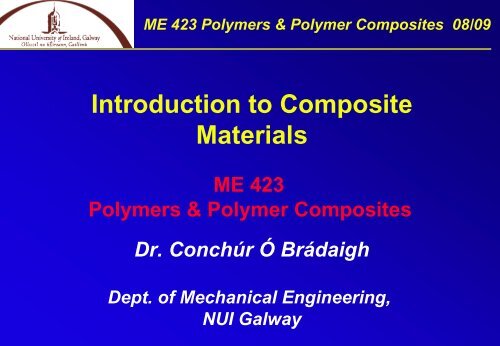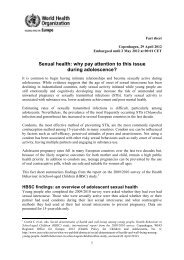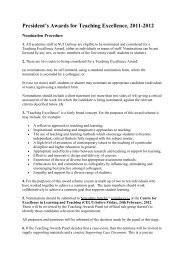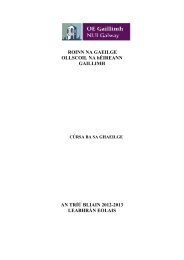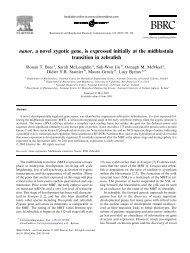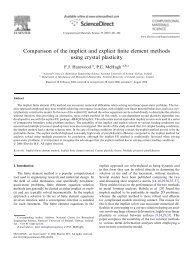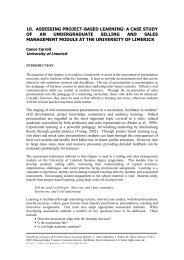Introduction to Composite Materials
Introduction to Composite Materials
Introduction to Composite Materials
You also want an ePaper? Increase the reach of your titles
YUMPU automatically turns print PDFs into web optimized ePapers that Google loves.
ME 423 Polymers & Polymer <strong>Composite</strong>s 08/09<br />
<strong>Introduction</strong> <strong>to</strong> <strong>Composite</strong><br />
<strong>Materials</strong><br />
ME 423<br />
Polymers & Polymer <strong>Composite</strong>s<br />
Dr. Conchúr Ó Brádaigh<br />
Dept. of Mechanical Engineering,<br />
NUI Galway
ME 423 Polymers & Polymer <strong>Composite</strong>s 08/09<br />
<strong>Introduction</strong> <strong>to</strong> <strong>Composite</strong>s<br />
• Advanced composites<br />
• what do they consist of ?<br />
– fibres and resins<br />
• where are they used ?<br />
- many areas of industry<br />
e.g. Aerospace, Marine, Au<strong>to</strong>motive, Infrastructure,<br />
Wind Energy, Biomedical<br />
• Manufacturing processes (Lecture 2)<br />
- Thermosets, Thermoplastics
ME 423 Polymers & Polymer <strong>Composite</strong>s 08/09<br />
<strong>Composite</strong> <strong>Materials</strong><br />
• Combination of two or more distinct material<br />
phases in<strong>to</strong> one engineering material<br />
• Two components:<br />
- Matrix & Reinforcement<br />
• Matrix - Protects Reinforcement<br />
- Environmental Tolerance<br />
• Reinforcement - Supports Structural Load
ME 423 Polymers & Polymer <strong>Composite</strong>s 08/09<br />
<strong>Composite</strong> <strong>Materials</strong><br />
MATRIX + REINFORCEMENT<br />
Polymer Carbon fibre<br />
Metal Glass fibre<br />
Ceramic Aramid fibre (e.g. Kevlar)<br />
Metal fibre (e.g. Ti, Al)
Short Fibres<br />
ME 423 Polymers & Polymer <strong>Composite</strong>s 08/09<br />
<strong>Composite</strong> <strong>Materials</strong><br />
Aligned Fibres<br />
“Advanced <strong>Composite</strong>s”
ME 423 Polymers & Polymer <strong>Composite</strong>s 08/09<br />
Carbon Fibres<br />
Courtesy of Tenax Fibers
ME 423 Polymers & Polymer <strong>Composite</strong>s 08/09<br />
Carbon Fibres<br />
• May be manufactured from PAN or Pitch<br />
• Lightweight<br />
• High performance<br />
• High strength - intermediate modulus – high modulus<br />
• Lower modulus – intermediate strength – lower strength<br />
• High electrical and thermal conductivity<br />
• Dimensional stability (negative CTE in fibre direction)<br />
• Relatively expensive (aerospace grade $30-50/Kg)<br />
• Transversely isotropic<br />
• Relatively brittle<br />
• Not very damage resistant
ME 423 Polymers & Polymer <strong>Composite</strong>s 08/09<br />
Aramid Fibres (e.g. Kevlar®)<br />
• High Tensile Strength at Low Weight<br />
• High Toughness & High Modulus<br />
• Low Electrical Conductivity<br />
• High Chemical Resistance<br />
• Low Thermal Shrinkage<br />
• Excellent Dimensional Stability<br />
• High Cut Resistance<br />
• Flame Resistant, Self-Extinguishing<br />
• Tends <strong>to</strong> absorb water (hygroscopic)<br />
• Problems in compression strength<br />
• Poor interfacial strength with matrix<br />
• Also expensive Courtesy of EI DuPont De Nemours
ME 423 Polymers & Polymer <strong>Composite</strong>s 08/09<br />
Glass Fibres<br />
• Cheap – most widely used reinforcement<br />
• Properties vary from low <strong>to</strong> medium<br />
• Good impact properties<br />
• Low electrical conductivity<br />
• Higher failure strains than carbon<br />
• E-Glass – strength, stiffness, weathering,<br />
electrical props.<br />
• S-Glass – higher modulus and strength,<br />
aircraft applics.<br />
• C-Glass – chemical resistance<br />
• Relatively heavy<br />
• Prone <strong>to</strong> moisture absorption<br />
• Can suffer surface damage<br />
Courtesy Owens Corning
ME 423 Polymers & Polymer <strong>Composite</strong>s 08/09
ME 423 Polymers & Polymer <strong>Composite</strong>s 08/09<br />
Material Properties<br />
Material Modulus Strength Relative<br />
(GPa) (MPa) Density<br />
Steels 203 600-2000 7.8<br />
Aluminium 75 70-80 2.6<br />
Carbon fibre (HM) 340 2500 1.9<br />
Carbon fibre (HS) 230 3200 1.8<br />
Aramid fibre 124 2800 1.45<br />
Glass fibre 76-86 1700 2.5
ME 423 Polymers & Polymer <strong>Composite</strong>s 08/09<br />
<strong>Composite</strong> Matrices<br />
Thermoset Resins<br />
• Polyester (GRP) – cheap and widest use<br />
• Epoxy – more expensive, better mech props<br />
• Phenolics – fire resistance<br />
• High temp. polyimides – v. expensive<br />
Thermoplastic Polymers<br />
• Polypropylene – cheapest, mainly with glass fibres<br />
• Nylons – industrial uses – some with carbon fibres<br />
• Polycarbonate, PET – more exotic<br />
• PEI, PES, PPS, PEEK – v. high props, v. high cost
ME 423 Polymers & Polymer <strong>Composite</strong>s 08/09<br />
Production of <strong>Composite</strong> –<br />
PreImpregnated Tape (Prepreg)<br />
Fibres are introduced in<strong>to</strong> resin in continuous<br />
resin impregnation process – rolled up on paper<br />
backing – ready for component manufacturing
Unidirectional<br />
Pre-impregnated<br />
Tape (Prepreg)<br />
ME 423 Polymers & Polymer <strong>Composite</strong>s 08/09<br />
+ Pressure + Heat<br />
Fabrics<br />
Aircraft<br />
Trailing<br />
Edge SUPreM
ME 423 Polymers & Polymer <strong>Composite</strong>s 08/09<br />
Micromechanics Combining Rules<br />
e.g. Rule of Mixtures<br />
E (long) = Ef . Vf + Em . Vm<br />
E (transverse) = EmEf<br />
Vf . Em + Vm. Ef<br />
Em = Matrix modulus, Vm = matrix volume fraction,<br />
Ef = Fibre Modulus, Vf = fibre volume fraction<br />
Vm + Vf = 1
ME 423 Polymers & Polymer <strong>Composite</strong>s 08/09<br />
<strong>Composite</strong> Material Properties<br />
Material Fibre Modulus Strength<br />
Volume (GPa) (MPa)<br />
Steels ---- 203 600-2000<br />
Aluminium ---- 75 70-80<br />
UD CF/Epoxy 0.6 180 1500<br />
UD Kevlar/Epoxy 0.6 76 1400<br />
UD CF/PEEK 0.66 134 2130<br />
UD GF/Epoxy 0.6 50 1200<br />
All composite properties measured in fibre direction
ME 423 Polymers & Polymer <strong>Composite</strong>s 08/09<br />
…...the <strong>Composite</strong> Advantage is Weight<br />
Material Specific Specific<br />
Modulus Strength<br />
UD CF/Epoxy 113 937<br />
UD CF/PEEK 84 1330<br />
UD Kevlar/Epoxy 52 965<br />
Aluminium 30 30<br />
UD GF/Epoxy 21 590<br />
Steels 26 76-255<br />
Specific properties are normalised by relative density
ME 423 Polymers & Polymer <strong>Composite</strong>s 08/09<br />
Improving Fibre Properties<br />
Carbon fibres: Modulus Strength<br />
(GPa) (MPa)<br />
T700 (HS) 235 5300<br />
HTS (HS) 238 4300<br />
IM6 / IM7 (IM) 303 5200<br />
HR40 (HM) 381 4800<br />
HS40 (UHM) 441 4400
ME 423 Polymers & Polymer <strong>Composite</strong>s 08/09<br />
Applications of <strong>Composite</strong>s<br />
Where the increased performance/reduced weight will<br />
pay for the increased cost of manufacture<br />
Ordered according <strong>to</strong> value per Kg weight saved:<br />
– Space (antennae, structures,satellite dishes etc)<br />
– Military Aircraft (wings, fuselage etc.)<br />
– Formula One (practically everything)<br />
– Civil aircraft (control surfaces, floor beams, empennage)<br />
– New civil aircraft (wings, fuselage)<br />
– Personalised protection (sports, ballistic armour)<br />
– Specialised au<strong>to</strong>motive (e.g. Lotus, Ferraris)<br />
– Wind turbine blades<br />
– Marine (yachts, offshore structures)
ME 423 Polymers & Polymer <strong>Composite</strong>s 08/09<br />
<strong>Composite</strong>s in Aerospace<br />
<strong>Composite</strong>s in use in space/military aircraft since<br />
late 1960s.<br />
B2 Bomber RAH 66 Comanche Helicopter
ME 423 Polymers & Polymer <strong>Composite</strong>s 08/09<br />
Eurofighter<br />
Typhoon<br />
Source:<br />
EADS<br />
Deutschland
ME 423 Polymers & Polymer <strong>Composite</strong>s 08/09<br />
Application - Aerospace<br />
<strong>Composite</strong>s being increasingly used<br />
in commercial aircraft
Traditional - Interiors<br />
Floor beams, seats,<br />
overhead bins, galleys<br />
ME 423 Polymers & Polymer <strong>Composite</strong>s 08/09<br />
Traditional - Structure<br />
Empennage, bulkheads,<br />
control surfaces, engine<br />
cowlings, fairings etc.
CF/Epoxy<br />
spoilers<br />
ME 423 Polymers & Polymer <strong>Composite</strong>s 08/09<br />
Quartz fibre radome<br />
GF/Phenolic<br />
Smoke -<br />
detec<strong>to</strong>r<br />
housing
ME 423 Polymers & Polymer <strong>Composite</strong>s 08/09<br />
A – 380 “Super-Jumbo”<br />
• Many innovative composite applications<br />
• 25% structural weight in composites
ME 423 Polymers & Polymer <strong>Composite</strong>s 08/09<br />
Source: EADS Deutschland
ME 423 Polymers & Polymer <strong>Composite</strong>s 08/09<br />
Source: EADS Deutschland
Source: EADS Deutschland<br />
ME 423 Polymers & Polymer <strong>Composite</strong>s 08/09
Boeing 787<br />
– Dreamliner<br />
Entry in<strong>to</strong> Service 2011<br />
ME 423 Polymers & Polymer <strong>Composite</strong>s 08/09<br />
• Longer range, more fuel-efficient aircraft<br />
• Over 50% structural weight in composites
ME 423 Polymers & Polymer <strong>Composite</strong>s 08/09<br />
Boeing 787 (EIS 2011)<br />
First 7m composite<br />
fuselage section<br />
shown<br />
Enables bigger<br />
windows, higher<br />
cabin pressure and<br />
higher humidity,<br />
12 year D-Check<br />
Maintenance interval
ME 423 Polymers & Polymer <strong>Composite</strong>s 08/09<br />
Airbus A350 XWB (planned 2013)<br />
• Competi<strong>to</strong>r <strong>to</strong> 787<br />
• Longer range, more fuel-efficient aircraft<br />
• Over 50% composite structure
ME 423 Polymers & Polymer <strong>Composite</strong>s 08/09<br />
New Aerospace <strong>Materials</strong><br />
Fibre-Metal Laminates (e.g. GLARE)<br />
Laminates of Al and CF/Epoxy<br />
Improved impact and fire<br />
resistance over Al & composites<br />
Better fatigue resistance than<br />
aluminium<br />
Used for upper fuselage of A-380
ME 423 Polymers & Polymer <strong>Composite</strong>s 08/09<br />
Issues in Aerospace<br />
• <strong>Composite</strong>s manufacturing processes still not au<strong>to</strong>mated<br />
sufficiently<br />
• How will single-aisle replacements (Boeing 737 & Airbus A-<br />
320 family) be made in composites (60 A/C per month each) ?<br />
• <strong>Composite</strong>s don’t fatigue or corrode like aluminium (great!)<br />
• Damage <strong>to</strong>lerance seen <strong>to</strong> be a problem (CF / epoxy)<br />
- developments in thermoplastics<br />
- fibre / metal laminates<br />
• Cost….Cost……Cost
ME 423 Polymers & Polymer <strong>Composite</strong>s 08/09<br />
Application - Marine
ME 423 Polymers & Polymer <strong>Composite</strong>s 08/09<br />
<strong>Composite</strong>s in Marine/Offshore<br />
Lightweight composite sandwiches are material<br />
of choice for yacht hulls, minesweepers etc.<br />
Offshore oil rigs, risers, platforms with special<br />
resin grades for maritime environment<br />
New closed-mould, in-bag infusion technologies<br />
larger mouldings, less environmental impact<br />
Smart fibre optics embedded in yacht masts
ME 423 Polymers & Polymer <strong>Composite</strong>s 08/09<br />
Application - Au<strong>to</strong>motive<br />
Bus interiors and exterior panels
ME 423 Polymers & Polymer <strong>Composite</strong>s 08/09<br />
Bus panels moulded in GF/PP (Twintex)
ME 423 Polymers & Polymer <strong>Composite</strong>s 08/09<br />
Application - Au<strong>to</strong>motive<br />
Daimler-Chrysler<br />
Dodge ESX-3<br />
EJ 11
ME 423 Polymers & Polymer <strong>Composite</strong>s 08/09<br />
<strong>Composite</strong>s in Au<strong>to</strong>motive<br />
Mainly short-fibre reinforced thermosets (SMC) and<br />
thermoplastics (GMT & filled inj. Mouldings)<br />
Pickup-bed covers, bonnets, front-end carriers,<br />
seats, spoilers, rocker and valve covers etc.<br />
Advanced composites structural elements/body<br />
panels being developed - electric car<br />
Recyclability & sustainability very important<br />
thermoplastic matrices<br />
natural fibres - flax, jute, sisal, hemp
ME 423 Polymers & Polymer <strong>Composite</strong>s 08/09<br />
Application - Infrastructure<br />
Shear reinforcement in<br />
construction<br />
Reinforcement of support props<br />
or anchor bolts in tunnel<br />
construction
150<br />
ME 423 Polymers & Polymer <strong>Composite</strong>s 08/09<br />
Strengthening with CFRP laminates<br />
load [kN]<br />
strengthened with<br />
CFRP laminates<br />
steel reinforced<br />
concrete beam<br />
midspan<br />
deflection<br />
[mm]<br />
0 100<br />
after failure<br />
i b<br />
k
ME 423 Polymers & Polymer <strong>Composite</strong>s 08/09<br />
<strong>Composite</strong>s in Infrastructure<br />
Carbon fibre prices now dropping rapidly, as low as<br />
$12/kg for large <strong>to</strong>ws<br />
Rehabilitation of bridges/buildings with CF<br />
plates/strips at minimum cost and inconvenience<br />
Seismic retrofitting of columns with CF wraps<br />
All-composite foot bridges from pultruded sections<br />
All-composite vehicular bridges coming in<strong>to</strong> service
ME 423 Polymers & Polymer <strong>Composite</strong>s 08/09<br />
Innovative Tubular Grid Structures<br />
Grid structures can be<br />
designed for optimum<br />
properties - combinations of<br />
<strong>to</strong>rsion & flexure, include<br />
redundant members for<br />
impact & durability<br />
ig.6: Structural grid structure<br />
(Pho<strong>to</strong>: ABB)
ME 423 Polymers & Polymer <strong>Composite</strong>s 08/09<br />
Wind Energy<br />
• Wind market growing worldwide at 15%/annum<br />
• Blades up <strong>to</strong> 50m long made of glass-fibre/epoxy<br />
• Next generation 50-60m for offshore sites –<br />
size means use of carbon fibre for stiffness<br />
• Denmark aims <strong>to</strong> supply 20% of its own<br />
energy by wind power by 2010<br />
• Irish Government target of 30% generation<br />
of electricity from renewables by 2020
Wind Energy<br />
ME 423 Polymers & Polymer <strong>Composite</strong>s 08/09
Wind Energy<br />
ME 423 Polymers & Polymer <strong>Composite</strong>s 08/09
Wind Energy<br />
ME 423 Polymers & Polymer <strong>Composite</strong>s 08/09
ME 423 Polymers & Polymer <strong>Composite</strong>s 08/09<br />
40m Wind Turbine Blade
Skins/Shells<br />
ME 423 Polymers & Polymer <strong>Composite</strong>s 08/09<br />
Box-Spar<br />
Hub<br />
Connection
ME 423 Polymers & Polymer <strong>Composite</strong>s 08/09<br />
Application - Biomedical Implants<br />
• Polymeric composites are transparent <strong>to</strong> radio waves &<br />
non-magnetic<br />
metals produce artifacts under CAT scans & MRI<br />
• Polymer matrices can be bio-inert or biodegradable<br />
• <strong>Composite</strong>s are anisotropic, so properties can be tailored<br />
by varying fibre volume fraction<br />
by varying the angle of reinforcement<br />
by changing the local density/form of reinforcement
ETH Zurich<br />
ME 423 Polymers & Polymer <strong>Composite</strong>s 08/09<br />
Bone Fixation Screws (CF/PEEK)<br />
CF/PEEK screws<br />
Metal screws
ETH Zurich<br />
ME 423 Polymers & Polymer <strong>Composite</strong>s 08/09<br />
Bone Fixation Plate (CF/PEEK)<br />
Holes moulded-<br />
In using CF/PEEK<br />
fabric rather<br />
than by<br />
machining


